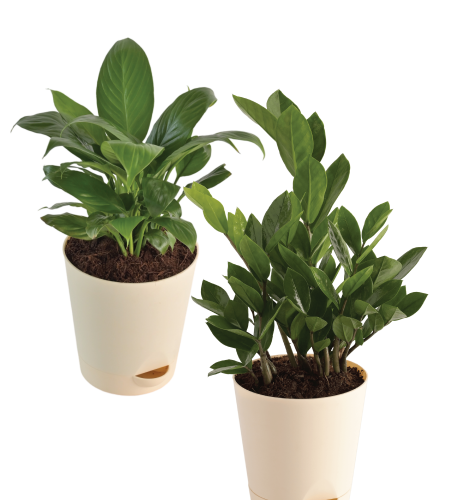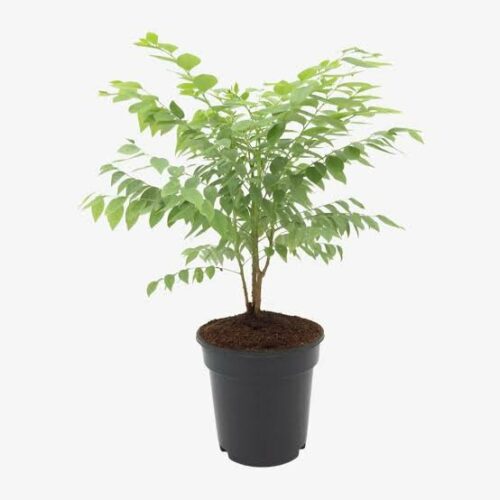Watermelon peperomia (Peperomia argyreia) have exploded in popularity among houseplant lovers thanks to their stunning watermelon-patterned foliage. They have a compact growth habit, and their leaves are not only colorful but also have a shimmery appearance that is especially stunning when the sunlight catches them. Native to South America, watermelon peperomia are tropical plants that grow naturally in the rainforest understory, and adapt exceptionally well to indoor growing.
Watermelon Peperomia Care
Overall watermelon peperomia are easy to care for and grow as houseplants, especially if you are good at staying on top of watering your plants. If you have a habit of forgetting to water your plants for weeks at a time, this plant might not be for you as peperomia are moisture-loving plants. While they do produce flower spikes in the spring and summer, the blooms are insignificant and some growers choose to cut the blooms off so that the plant can focus its energy on producing foliage instead.
Light
Choose a location for your watermelon peperomia that receives bright to medium indirect light. They should not be exposed to prolonged periods of direct sunlight as their leaves are prone to burning. While they can survive in lower light conditions, their leaves will be smaller and the growth will be more leggy.
Soil
These peperomia do well in most standard potting mixes as long as they are well-draining, but can also hold some moisture. Avoid soil that is formulated for plants that prefer a dryer soil like cacti and succulents as it won’t absorb enough water to sustain the plant. A 1:1 mixture of peat moss and perlite will also work for watermelon peperomia.
Water
Allow the top couple inches of soil to dry out between watering and then water thoroughly. Watermelon peperomia are sensitive to both overwatering and underwatering and should not be allowed to dry out or be left sitting in water for an extended period of time.
Temperature and Humidity
Watermelon peperomia do well in warm, slightly humid conditions. That being said, typical household temperatures and humidity levels are adequate for these tropical plants. Just ensure that your peperomia is kept away from vents or drafty windows that could dry out the air around the plant.
Fertilizer
These peperomia can benefit from regular fertilization during the growing period. Use a balanced liquid fertilizer every 2-4 weeks during the spring and summer.
Propagating Watermelon Peperomia
Watermelon peperomia are delightfully easy to propagate and are sometimes even affectionately referred to as “friendship plants” due to how easy it is to share your plant with a friend. Propagating should ideally be done during the growing season, either in the spring or summer. Watermelon peperomia can be propagated in two main ways: by division and by leaf cuttings.
A happy and healthy watermelon peperomia will begin to send up offshoots/pups that can be divided and planted in their own pots. To propagate by division, follow these steps:
First, remove the entire plant from the potting container so that you can examine the roots and carefully separate the offshoots.
Identify the offshoots that you want to separate from the plant (it is best to leave offshoots that are smaller than 1 inch in the original pot) and gently tease the roots from the main plant.
Plant the newly separated offshoot in its own pot and water the soil thoroughly.
Place it in a location that receives medium to bright indirect light and keep the soil consistently moist for the first 1-2 weeks after separation.
After a couple of weeks you can resume a regular watering schedule.
Unlike leaf/stem propagating with other plants, watermelon peperomia do not branch at the location where the stem is cut, so once you cut a leaf off you are sacrificing that stem permanently. Keep this in mind before getting started. Interestingly, there are two ways to propagate with a single leaf cutting.
To propagate by leaf cuttings, follow these steps:
Identify the leaves that you want to use and cut the stem so that the separated leaf has 2-3 inches of stem remaining.
Take the separated leaf, and cut the leaf in half – separating the “top” and the “bottom” of the leaf. You will be left with two halves, one that has the stem still attached.
Prepare a container with regular potting soil and pre-moisten the soil before planting.
Take the top half of the leaf cutting and place it in the soil with the cut edge buried and the top half above the soil.
Then, take the bottom half of the cutting and plant the stem in the soil, with the remainder of the leaf above the soil.
Then, place your freshly potted cuttings in a location that receives medium to bright indirect light and keep the soil consistently moist but never waterlogged.
After 1-2 months you should notice new growth sprouting from the leaves/stems of the cuttings. Allow the new plants to establish for a couple of months before transplanting them to their own containers.
Common Pests & Plant Diseases
These plants are susceptible to a number of common houseplant pests and diseases. Fungus gnats and sap-sucking pests such as mealybugs, scale, and aphids can all be problems for watermelon peperomia. These peperomia are also sensitive to overwatering and can develop root rot quickly if their watering is mismanaged.


![Rotala rotundifolia 'Green' [Tc]](https://elysianflora.com/wp-content/uploads/2021/12/Tishu_products_10-500x500.jpg)









Reviews
There are no reviews yet.